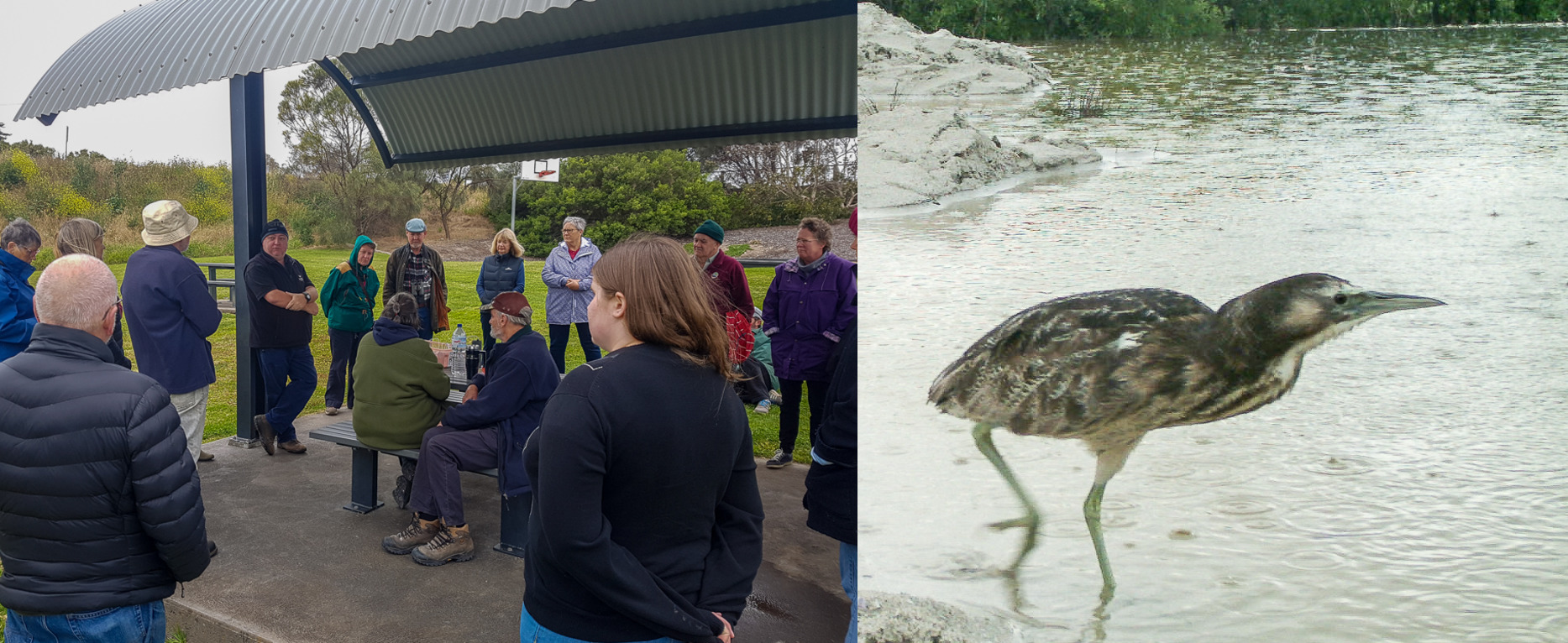Big bittern survey of Long Swamp reveals some rare finds
Last Saturday, the Bittern Recovery Project and NGT ran a field survey for Australasian Bittern (Botaurus poiciloptilus) in Long Swamp, near Nelson in south-west Victoria. Since NGT’s hydrological restoration work at Nobles Rocks, the wetland has seen an increase in suitable habitat for the nationally-endangered bittern and other wetland species. After numerous recent sightings near our project site at Nobles Rocks, we were curious as to whether we’d be able to detect them calling across larger parts of the wetland.
A great turnout of 28 volunteers met at Nelson beforehand for an outdoor workshop session and a BBQ. Bob Green from Bittern Recovery ran through the habitat needs, cryptic behavior and unique call of the bittern. Despite being a relatively large bird, it is extremely hard to spot and rarely seen unless flushed from cover. Like other herons it quietly watches and waits for prey or slowly stalks through dense reeds and rushes at the edge of wetlands staying well hidden. However, it will often call during breeding season (October – February) so we were in with a chance.
Listen to different examples of the call here and here.

Bob Green explains the survey method (left), and what we were looking for, and the Australasian Bittern photographed near Nobles Rocks in June (right). Photos: Jonathan Tuck.
With Long Swamp running from Lake Momboeng in the east and exiting nearly 20km west at Oxbow Lake in the Glenelg River Estuary, there’s a lot of suitable bittern habitat to cover! Fortunately, we had ten groups of keen listeners out on site, giving reasonable coverage. Despite the geographic challenge, volunteers Cassie and Sue were fortunate to hear a bittern on dusk. It called just twice, and luckily the team were in the right spot and sharp enough to pick up the call.

The Eastern Ground Parrot (Pezoporus wallicus). Photo: Christopher Grounds, in Australian Geographic.
In a welcome surprise, the team also picked up the elusive Eastern Ground Parrot (Pezoporus wallicus) – very rarely heard in these parts! In fact, Long Swamp now forms the western edge of the modern range for this species which used to occur across many of the coastal wetlands of South Australia (where the species is now considered extinct). [For our Adelaide readers, you may be surprised to learn that the Eastern Ground Parrot was once known to occur as far west as the Adelaide Plains, prior to the channelisation of the River Torrens and drainage of the Reedbeds.]
Our group of three Nelson volunteers set up at the edge of the coastal scrub on a dune, east of the Nobles Rocks structure. We tuned into the coastal hum and watched Yellow-tailed Black Cockatoos at the edge of the swamp, bending the branches of shrubs that were a bit too small for them. A Swamp Harrier buzzed the wetland and settled in a tree nearby as the dusk closed in. A low sound pulsed through from the west, mixed with the churn of the ocean beach, and there again… was it the bittern? We strained to hear – but couldn’t get enough to confidently confirm it.
When our hour of listening was up, it was a slow drive back to Nelson, gently braking for the occasional Red-neck Wallaby or Ring-tail Possum hustling across the road, to check in and hear the stories from other groups. Later on, NGT ecologist Lachie Farrington confirmed that he’d detected a bittern earlier on an audio recorder just to the west of our listening spot, so maybe we heard it after all!
Thanks to Bob Green from Bittern Recovery for running a great workshop and survey, and to all the volunteers for getting out in this wild corner of south-west Victoria. It was good to see plenty of locals as well as a few who travelled from afar.
Extra thanks as always to Nelson Coastcare who have been long-time supporters of the Long Swamp restoration work, and to the Glenelg Hopkins CMA and Victorian Government for supporting the Bittern Recovery and Long Swamp restoration projects.

